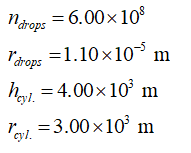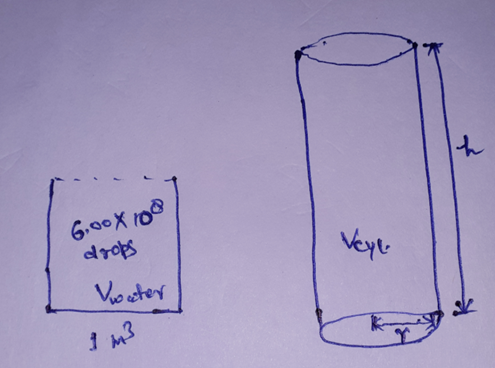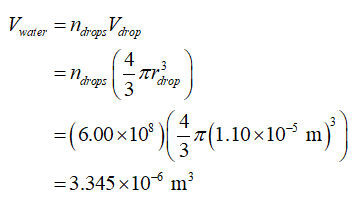One cubic meter of a cumulus contains 6.00x108 water drops, which have a radius of 1.10 x10 m. How many cubic meters of water are in a cylindrical cumulus cloud of height 4.00x10 m and radius 3.0x10 m? Note: 1.00 cm 1.00 x10 m; V sphere r°; V cylinder = r?h. %3D - Answer: Fill in the blank by providing the final answer. In the box below please show how you found the final answer. Include the appropriate sketches.
One cubic meter of a cumulus contains 6.00x108 water drops, which have a radius of 1.10 x10 m. How many cubic meters of water are in a cylindrical cumulus cloud of height 4.00x10 m and radius 3.0x10 m? Note: 1.00 cm 1.00 x10 m; V sphere r°; V cylinder = r?h. %3D - Answer: Fill in the blank by providing the final answer. In the box below please show how you found the final answer. Include the appropriate sketches.
College Physics
11th Edition
ISBN:9781305952300
Author:Raymond A. Serway, Chris Vuille
Publisher:Raymond A. Serway, Chris Vuille
Chapter1: Units, Trigonometry. And Vectors
Section: Chapter Questions
Problem 1CQ: Estimate the order of magnitude of the length, in meters, of each of the following; (a) a mouse, (b)...
Related questions
Topic Video
Question
Question 1 using the solution template provided
![---
**Complete Solution Template**
This template aids in the thorough and structured solving of assigned problems. It ensures clarity and comprehensiveness in your approach to problem-solving.
**I) Identify the physical quantities and visualize the situation**
1) **Given quantities:**
- [Write the given quantities here.]
2) **Unknown quantities:**
- [Write the unknown quantities that need to be determined here.]
3) **Sketch the situation given in the problem:**
- [Draw a diagram representing the problem situation here.]
**II) Identify the physics principles involved and the corresponding generic/textbook equations**
4) **Principle(s)/Key idea(s):**
- [Indicate the main physics principles or key ideas that will be used to solve the problem.]
5) **Equations:**
- [List the relevant equations or formulas that apply to this problem.]
**III) Plan and execute your solution**
6) **State your plan:**
- [Outline the strategy or steps you plan to take to solve the problem.]
7) **Algebraic solution:**
- [Work out the problem algebraically, showing all steps in the solution.]
8) **Numeric solution:**
- [Substitute the numerical values into the equations and solve.]
**IV) Self check**
9) **Unit and number check:**
- [Verify that the units and numbers in your solution make sense.]
10) **Does your result make sense? Why?**
- [Reflect on your solution to ensure it is logical and aligns with the principles and concepts discussed.]
---
By following this template, you will ensure a clear and methodical approach to solving physics problems, enhancing both understanding and accuracy.](/v2/_next/image?url=https%3A%2F%2Fcontent.bartleby.com%2Fqna-images%2Fquestion%2Fe559c78b-2db2-49bb-be84-bfa794bcb4bb%2F48059f55-df87-4a56-b250-f588cec61c42%2F72ukdl.jpeg&w=3840&q=75)
Transcribed Image Text:---
**Complete Solution Template**
This template aids in the thorough and structured solving of assigned problems. It ensures clarity and comprehensiveness in your approach to problem-solving.
**I) Identify the physical quantities and visualize the situation**
1) **Given quantities:**
- [Write the given quantities here.]
2) **Unknown quantities:**
- [Write the unknown quantities that need to be determined here.]
3) **Sketch the situation given in the problem:**
- [Draw a diagram representing the problem situation here.]
**II) Identify the physics principles involved and the corresponding generic/textbook equations**
4) **Principle(s)/Key idea(s):**
- [Indicate the main physics principles or key ideas that will be used to solve the problem.]
5) **Equations:**
- [List the relevant equations or formulas that apply to this problem.]
**III) Plan and execute your solution**
6) **State your plan:**
- [Outline the strategy or steps you plan to take to solve the problem.]
7) **Algebraic solution:**
- [Work out the problem algebraically, showing all steps in the solution.]
8) **Numeric solution:**
- [Substitute the numerical values into the equations and solve.]
**IV) Self check**
9) **Unit and number check:**
- [Verify that the units and numbers in your solution make sense.]
10) **Does your result make sense? Why?**
- [Reflect on your solution to ensure it is logical and aligns with the principles and concepts discussed.]
---
By following this template, you will ensure a clear and methodical approach to solving physics problems, enhancing both understanding and accuracy.
![## Physics Problems
### Problem 1
One cubic meter of a cumulus contains 6.00×10<sup>8</sup> water drops, which have a radius of 1.10 ×10<sup>-5</sup> m. How many cubic meters of water are in a cylindrical cumulus cloud of height 4.00×10<sup>3</sup> m and radius 3.0×10<sup>3</sup> m? Note: 1.00 cm = 1.00 ×10<sup>-2</sup> m; V<sub>sphere</sub> = \(\frac{4π}{3} r^3\); V<sub>cylinder</sub> = πr<sup>2</sup>h.
**Answer: __________________________________
Fill in the blank by providing the final answer. In the box below please show how you found the final answer. Include the appropriate sketches.
```
[Box for solution and sketches]
```
### Problem 2
On a wet road, a car with good tires may be able to brake with a constant deceleration of 2.00 m/s<sup>2</sup>.
(a) How long does such a car, initially traveling at 10.0 m/s, take to stop? **Answer: _________**
(b) How far does it travel in this time? **Answer: _______________
Fill in the blanks by providing the final answer. In the box below please show how you found the final answers.
```
[Box for solution and sketches]
```](/v2/_next/image?url=https%3A%2F%2Fcontent.bartleby.com%2Fqna-images%2Fquestion%2Fe559c78b-2db2-49bb-be84-bfa794bcb4bb%2F48059f55-df87-4a56-b250-f588cec61c42%2Fy62qjfa.jpeg&w=3840&q=75)
Transcribed Image Text:## Physics Problems
### Problem 1
One cubic meter of a cumulus contains 6.00×10<sup>8</sup> water drops, which have a radius of 1.10 ×10<sup>-5</sup> m. How many cubic meters of water are in a cylindrical cumulus cloud of height 4.00×10<sup>3</sup> m and radius 3.0×10<sup>3</sup> m? Note: 1.00 cm = 1.00 ×10<sup>-2</sup> m; V<sub>sphere</sub> = \(\frac{4π}{3} r^3\); V<sub>cylinder</sub> = πr<sup>2</sup>h.
**Answer: __________________________________
Fill in the blank by providing the final answer. In the box below please show how you found the final answer. Include the appropriate sketches.
```
[Box for solution and sketches]
```
### Problem 2
On a wet road, a car with good tires may be able to brake with a constant deceleration of 2.00 m/s<sup>2</sup>.
(a) How long does such a car, initially traveling at 10.0 m/s, take to stop? **Answer: _________**
(b) How far does it travel in this time? **Answer: _______________
Fill in the blanks by providing the final answer. In the box below please show how you found the final answers.
```
[Box for solution and sketches]
```
Expert Solution
Step 1
The given quantities are,

Step 2
The number (N) of the cubic meter of water in the cylindrical columns cloud is to determined. To determine it, first calculate the volumes of the n water drops and the cylindrical columns, respectively. And, find the ratio of the volumes of the cylindrical columns to the volumes of the water drops.
Consider the diagram of the cubic meter column and cylindrical columns cloud.

Step 3
The volume of the n water drops, that is, the volume of water drops in the column of 1 m3, can be calculated as,

Step by step
Solved in 5 steps with 5 images

Knowledge Booster
Learn more about
Need a deep-dive on the concept behind this application? Look no further. Learn more about this topic, physics and related others by exploring similar questions and additional content below.Recommended textbooks for you

College Physics
Physics
ISBN:
9781305952300
Author:
Raymond A. Serway, Chris Vuille
Publisher:
Cengage Learning

University Physics (14th Edition)
Physics
ISBN:
9780133969290
Author:
Hugh D. Young, Roger A. Freedman
Publisher:
PEARSON

Introduction To Quantum Mechanics
Physics
ISBN:
9781107189638
Author:
Griffiths, David J., Schroeter, Darrell F.
Publisher:
Cambridge University Press

College Physics
Physics
ISBN:
9781305952300
Author:
Raymond A. Serway, Chris Vuille
Publisher:
Cengage Learning

University Physics (14th Edition)
Physics
ISBN:
9780133969290
Author:
Hugh D. Young, Roger A. Freedman
Publisher:
PEARSON

Introduction To Quantum Mechanics
Physics
ISBN:
9781107189638
Author:
Griffiths, David J., Schroeter, Darrell F.
Publisher:
Cambridge University Press

Physics for Scientists and Engineers
Physics
ISBN:
9781337553278
Author:
Raymond A. Serway, John W. Jewett
Publisher:
Cengage Learning

Lecture- Tutorials for Introductory Astronomy
Physics
ISBN:
9780321820464
Author:
Edward E. Prather, Tim P. Slater, Jeff P. Adams, Gina Brissenden
Publisher:
Addison-Wesley

College Physics: A Strategic Approach (4th Editio…
Physics
ISBN:
9780134609034
Author:
Randall D. Knight (Professor Emeritus), Brian Jones, Stuart Field
Publisher:
PEARSON